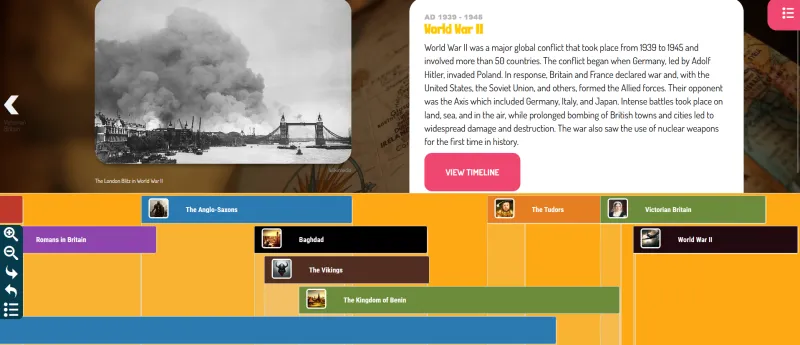Why an Interactive Primary Timeline is a Rewarding Way to Explore British and World History
Teaching history to primary children can be a challenge, especially when trying to convey the vastness of time and the relationships between global events and societies, which is why timelines are one of the simplest and most effective ways to improve children’s understanding of chronology.
Traditional timelines, often stretched across classroom walls using string or tape, may be visually appealing but have their limitations. An interactive primary timeline, however, offers a more efficient and dynamic approach to exploring history, bringing both British and World history to life in a way that is engaging, convenient, and efficient for both teachers and children.
Make the most of limited space
A key advantage of an interactive timeline is that it occupies no classroom space. Unlike traditional timelines, which can dominate classroom walls and need to be constantly updated or replaced, an interactive timeline is digital. This means it occupies no physical space and can be displayed on whiteboards, laptops, or tablets, making it easy to integrate into lessons in seconds. Teachers can seamlessly incorporate the timeline into their history lessons without needing to take it down afterwards or reprint sections if it becomes damaged, making it an easily accessible, practical, and time-saving resource.
View 19 periods of British and World history in seconds
A printed timeline can represent a single period of history, but setting it in a wider historical context is often impractical. In contrast, the Immersive History Interactive Primary Timeline offers a particularly rich and flexible experience for historical enquiry. By viewing the timeline overview, children can quickly see when different periods of British and World history occurred, and which occurred concurrently, thereby broadening their understanding of chronology. Each period is zoomable, allowing pupils to explore different eras, from the Paleolithic Period to World War II, while an easy-to-use search tool enables key events or significant people to be located quickly.
Compare two historical periods
Concurrence is a particularly difficult concept to teach, particularly using static timelines, but it’s a crucial skill for children if they are to deepen their understanding of historical narratives and make connections between different time periods, cultures, and societies. With an interactive timeline, teachers can easily compare two concurrent periods of history, using easy-to-see colour coded labels to differentiate between them. For example, children can compare the development of writing in Ancient Sumer and Ancient Egypt to observe the differences in styles and the time lapse between the emergence of different writing systems.
Customise the timeline for the needs of your school
A standout feature of the Immersive History Interactive Primary Timeline is the ability for teachers and pupils to add new events or significant people to any existing period. This unique customisation option allows timelines to be tailored to the pupil’s interests or specific historical enquiries. For instance, events from the school’s locality can be added as part of a local history study, or historical figures can be included to tie in with other subjects, such as biographical writing in English or learning about microbes in science. By customising the timeline, teachers can make the learning experience more engaging and relevant for pupils.
Find out more
For more information about the Immersive History Interactive Primary Timeline or see an online demo, please click here.

 School Login
School Login